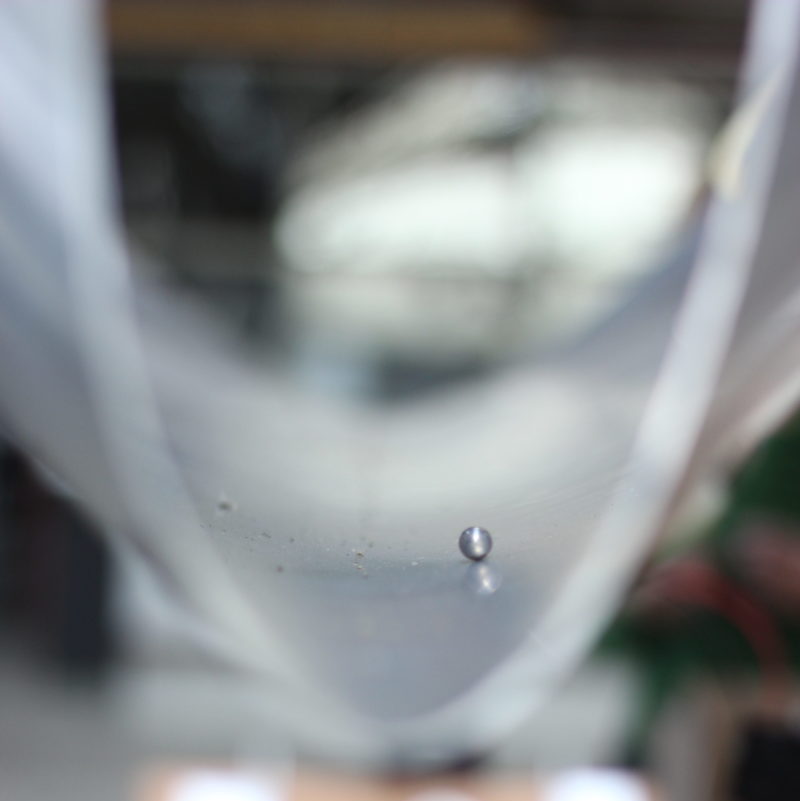“All Is Well” is an experiment with marble maze as the building block for a composed instrument. It uses the acoustic properties of everyday material to create a spatial sound composition in form of a reactive installation that is run by audience participation. This sculpted spatial composition immerses the audience, and in each venue takes a shape specific to that site.
“All Is Well” is silent unless it is activated by the audience. To participate, one has to carry a marble upstairs, and release it in an inlet that is provided at the top of the stairs. This inlet is the beginning for a continuously descending line of objects, and ends on the ground next to the same stairway that goes to its inlet. As one releases a marble in an inlet, the marble travels through the line, passing through the amplified nodes, and creating a moving sound source that resonates every object that it passes through. The installation consists of multiple of these lines. So, as multiple marbles are released simultaneously in multiple inlets, the installation becomes an orchestra of sounding objects that succeed and accompany one another as they resonate with the passing marbles, playing a multi-layered spatial sound composition.
As a member of audience, one can choose to be a passive spectator hoping for someone else to take a step and lift a marble, in which case one can experience the sound composition in full and from any spot of choice; or one can choose to step forward and lift the marble to the top of the stairs and activate the composition, in which case one has to climb back down before finding a suitable place to experience the piece, and possibly miss the beginning of the composition.
All Is Well in DordtYart, Sep 1st to Oct 7th, 2018
“All is Well” began as a playful reflection on “The Myth of Sisyphus” by Albert Camus. In this myth, Sisyphus is condemned to push back a stone up a hill just to let it roll back down, for eternity. In this text I am most amazed by Camus’ view on the “absurd hero”:
“At the very end of his long effort measured by skyless space and time without depth, the purpose is achieved. Then Sisyphus watches the stone rush down in a few moments toward that lower world whence he will have to push it up again toward the summit. He goes back down to the plain.
It is during that return, that pause, that Sisyphus interests me. A face that toils so close to stones is already stone itself!I see that man going back down with a heavy yet measured step toward the torment of which he will never know the end. That hour like a breathing-space which returns as surely as his suffering, that is the hour of consciousness.”
To focus on this “hour of consciousness” I decided to expand and magnify the physical phenomenon of a gradual descend, where one has to put effort into lifting an object in order to observe its fall.
During the process of sketching for this work, the idea behind the work shifted away from absurdity and eternal condemnation in Camus’ writing, and moved towards a playful piece for audience engagement.
Testing material for a new piece: This time I am experimenting with the concept of timeline, and this is the very first line for time to pass.
One can have a linear as well as a cyclical understanding of time through perceiving change and constance; the linear aspect of time exposes itself as one follows change in a phenomenon through differentiating (like during a sunset when the passing of time can be felt with the perceivable decrease of light), and its cyclical aspect can be tracked in what remains constant as one recognises the duration between the recurrences, such as recurrence of day/night, or the seasons. While one’s life experience passes through time in a linear manner, the way life is reflected in one’s mind is more than just that. How can more sides of our perception of time be reflected in the “timeline” of “All is well”?
Cardboard boxes can hold the line, but also amplify the sound of passing balls.
A large portion of human activity involves accumulating and reshaping spaces; international trades close distances between production and consumption sites, fences and borders create disproportionate distances between their either sides, and bridges allow taking a shorter route to cross a river. In other words through manipulation of matter in the environment, it takes less time for humans to move matter from one point to another. In a way, all vehicles can also be seen as efforts to reshape the space. What about musical instruments in a sonic space? How does an instrument facilitate moving from one sound to another? And how can such channels through space be incorporated in the making of the sonic space in “All is well”?
different materials, different behaviours
Time is considered to pass in a constant speed when one plans for day to day or year to year matters; however the lived experience is different, as one’s perception of time changes under different circumstances. When listening to music we experience such variations. How can different sound textures at different nodes on the timeline of “All is well” affect one’s perception of time?
On the other hand, sound is a temporal phenomenon, and one’s experience of it cannot be outside of time; yet one can have a grasp of such temporal event without having to experience it for its entire duration, for example when a musician can “read” a piece by looking at some musical notes. How can geometry (shape, location and distance) facilitate such overview on the timeline of the musical piece in “All is well”?










